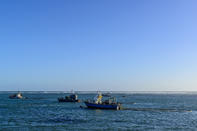A New Road
Due to the wealth found in copper mining and the inherent transport problems of getting the ore to sea, the opening of the Springbok to Port Nolloth road, ensured that Port Nolloth boomed. In 1856, the town had only a couple of inhabitants, four or five wooden houses and a single trading station, run by F.W. Dreyer.

By 1870, a few months after the tramway opened, it contained around 200 residents. Captain Nolloth himself, now retired, was appointed as the first harbour master. Unfortunately, it remained an unattractive place. Makeshift houses sprawled across the soft sand, along with a number of canteens and bars. There was no jail or magistrate, and living conditions were very rough.
But it was, in many ways, a far superior port to Hondeklip, with a safe inner anchorage protected from the elements. In the early days, sacks of ore were carried down to the beach and into the sea by indians, who then heaved the bags into the bobbing boats. By 1874, a jetty had been constructed with a miniature railway that ran along its length, allowing the ore to be dumped directly into the waiting vessels.
Moorings and navigational beacons were erected, and a fortnightly ship from Cape Town brought in the much-needed supplies. In the same year, Port Nolloth became a magisterial district and a customs officer was appointed. Drinking water for the settlement was sourced from a spring about 5 miles away and transported into town on a ‘rol-vaatjie’ (basically a barrel fitted to an axle).
Prosperity Falls

By 1882, Port Nolloth had 2000 inhabitants and the Namaqua, a Union Castle steamer, regularly plied the Cape Town-Port Nolloth route. Unfortunately, there was no proper landing area for passengers and, to get from a boat to the jetty, you either had to climb up a rocking ladder or get hoisted ashore in a basket that dangled from a wire pulley.
The town continued to grow apace. 1886 saw the establishment of a newspaper and a cricket club. 1896 saw the installation of a sanitation system. A lighthouse was erected in 1909. But the fortunes of Port Nolloth took a tumble when the Cape Copper Company stopped production in 1919. Poverty overwhelmed what was, essentially, a mining town. Visitors in the 1930s reported seeing young children begging for a cup of fresh water. Fishing turned out to be the saving grace of Port Nolloth and today it is an attractive town with a well developed tourism infrastructure.